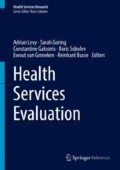Abstract
Health-care surveys serve as a critical source of essential information on trends in health-care costs, coverage, access, and health-care quality. The findings derived from these surveys often facilitate the development, implementation and evaluation of policies and practices addressing health care and health behaviors at the national level. This chapter serves to illustrate several survey methods that enhance the performance and utility of health services research efforts. Attention has been given to the topics of sample and survey designs, nonresponse and attrition, estimation, precision, sample size determination, and analytical techniques to control for survey design complexities in analysis. Several of the topics that are featured in this chapter are further connected by their substantive focus on the measurement of trends in health-care costs, coverage, access, and health-care utilization. In addition to highlighting underlying survey operations, estimates, and outputs, the topics that have been covered also serve to identify potential enhancements that facilitate improvements in design, data collection, estimation strategies, and ultimately analytical capacity for health services research efforts.
Access this chapter
Tax calculation will be finalised at checkout
Purchases are for personal use only
References
Botman S, Moore T, Moriarity C, Parsons V. Design and estimation for the National Health Interview Survey, 1995–2004. National Center for Health Statistics. Vital Health Stat. 2000;2(130)
Chromy J. Variance estimators for a sequential sample selection procedure. In: Krewski D, Rao J, Platek R, editors. Current topics in survey sampling. New York: Academic Press; 1981. p. 329–47.
Cochran W. Sampling techniques. New York: Wiley; 1977.
Cohen S. Methodology report #11: sample design of the 1997 Medical Expenditure Panel Survey household component. Rockville: Agency for Healthcare Research and Quality; 2000. http://www.meps.ahrq.gov/data_files/publications/mr11/mr11.shtml
Cohen S. Design strategies and innovations in the Medical Expenditure Panel Survey. Med Care. 2003;4(7):5–12.
Cohen S, Yu W. The utility of prediction models to oversample the long term uninsured. Med Care. 2009;47(1):80–7.
Cohen S, DiGaetano R, Goksel H. Methodology report #5: estimation procedures in the 1996 Medical Expenditure Panel Survey household component. Rockville: Agency for Healthcare Research and Quality; 1999. http://www.meps.ahrq.gov/data_files/publications/mr5/mr5.shtml
Cohen SB, Machlin S, Branscome J. Patterns of attrition and reluctant response in the 1996 Medical Expenditure Panel Survey. J Health Serv Outcome Res Methodol. 2000;1(2):131–48.
Cohen S, Ezzati-Rice T, Yu W. Integrated survey designs: a framework for nonresponse bias reduction. J Econ Soc Meas. 2005;30(2-3):101–14.
Cohen SB, Ezzati-Rice T, Yu W. The utility of extended longitudinal profiles in predicting future health care expenditures. Med Care. 2006a;44(5):45–53.
Cohen S, Ezzati-Rice T, Yu W. The impact of survey attrition on health insurance coverage estimates in a National Longitudinal Health Care Survey. J Health Serv Outcome Res Methodol. 2006b;6:111–25.
Cohen J, Cohen S, Banthin J. The Medical Expenditure Panel Survey: a national information resource to support healthcare cost research and inform policy and practice. Med Care. 2009;47(7):S1:44–50.
Cox B, Cohen, S. Methodological issues for health care surveys. New York/Basel: 1985: Marcel Dekker
Groves R, Heeringa S. Responsive design for household surveys: tools for actively controlling survey errors and costs. J R Stat Soc Ser A. 2006;169:439–57.
Groves R, Fowler F, Couper M, Lepkowski J, Tourangeau R. Survey methodology. 2nd ed. New York: Wiley; 2009.
Hansen M, Hurwitz W. The problem of nonresponse in sample surveys. J Am Stat Assoc. 1946;41:517–29.
Korn E, Graubard B. Analysis of health surveys. New York: Wiley; 1999.
Lynn P. Methodology of longitudinal surveys. Chichester: Wiley; 2009.
Madans J, Cohen S. Health surveys: a resource to inform health policy and practice. In: Health statistics in the 21st century: implications for health policy and practice. New York: Oxford University Press; 2005.
Rubin D. Multiple imputation for nonresponse in surveys. New York: Wiley; 1987.
Selden T, Hudson J. Access to care and utilization among children: estimating the effects of public and private coverage. Med Care. 2006;44(5):19–26.
Short P, Graefe D. Battery-powered health insurance? Stability in coverage of the uninsured. Health Aff. 2003;22(6):244–55.
Stinchcombe A, Jones C, Sheatsley P. Nonresponse bias for attitude questions. Public Opin Q. 1981;45:359–75.
Stoop I, Billiet J, Koch A, et al. Improving survey response. Chichester: Wiley; 2010.
Vartivarian S, Jang S, Salvucci S, Kasprzyk D. Subsampling nonrespondents: Issue of calculating response rates. In: Proceedings of the section on survey research methods. Alexandria: American Statistical Association; 2006. p. 3796–8.
Author information
Authors and Affiliations
Corresponding author
Editor information
Editors and Affiliations
Rights and permissions
Copyright information
© 2019 This is a U.S. government work and not under copyright protection in the U.S.; foreign copyright protection may apply
About this entry
Cite this entry
Cohen, S.B. (2019). Survey Methods in Health Services Research. In: Levy, A., Goring, S., Gatsonis, C., Sobolev, B., van Ginneken, E., Busse, R. (eds) Health Services Evaluation. Health Services Research. Springer, New York, NY. https://doi.org/10.1007/978-1-4939-8715-3_38
Download citation
DOI: https://doi.org/10.1007/978-1-4939-8715-3_38
Published:
Publisher Name: Springer, New York, NY
Print ISBN: 978-1-4939-8714-6
Online ISBN: 978-1-4939-8715-3
eBook Packages: MedicineReference Module Medicine

